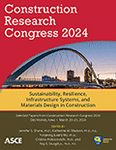Assessing Energy Performance and Thermal Satisfaction of Flexible Space Usage in Office Buildings
Publication: Construction Research Congress 2024
ABSTRACT
The tradeoffs between energy efficiency and thermal comfort in office buildings have been studied for decades. To date, researchers have proposed various strategies, such as occupant-based control strategies and personal comfort systems. Notably, operations of office buildings are embracing flexible work arrangements which allow occupant mobility, especially in the post-pandemic era. Research efforts on space recommendation strategies that match the needs of personal thermal preferences with different space conditions have been explored. However, existing literature lacks simultaneous quantification of energy consumption and thermal comfort at the whole building level when implementing flexible space usage. This paper quantitatively evaluates the influence of space match strategies on energy performance and thermal satisfaction in three typical office buildings of different sizes using the summer season. Our results demonstrate up to 22% cooling electricity savings and 15.7% increase in comfort probability across all simulated scenarios. These findings indicate that implementing space match strategies could improve building performance in both energy efficiency and thermal comfort to varying degrees.
Get full access to this article
View all available purchase options and get full access to this chapter.
REFERENCES
Andersen, M., G. Fierro, S. Kumar, J. Kim, E. Arens, H. Zhang, P. Raftery, and D. Culler. 2016. Well-connected microzones for increased building efficiency and occupant comfort.
Aryal, A., and B. Becerik-Gerber. 2018. “Energy consequences of Comfort-driven temperature setpoints in office buildings.” Energy and Buildings, 177: 33–46. https://doi.org/10.1016/j.enbuild.2018.08.013.
Aryal, A., B. Becerik-Gerber, F. Anselmo, S. C. Roll, and G. M. Lucas. 2019. “Smart Desks to Promote Comfort, Health, and Productivity in Offices: A Vision for Future Workplaces.” Frontiers in Built Environment, 5.
BCO (British Council for Offices). 2010. Making Flexible Working Work. BCO.
Daum, D., F. Haldi, and N. Morel. 2011. “A personalized measure of thermal comfort for building controls.” Building and Environment, 46 (1): 3–11. https://doi.org/10.1016/j.buildenv.2010.06.011.
Deru, M., et al. 2011. U.S. Department of Energy Commercial Reference Building Models of the National Building Stock.
Hoyt, T., K. H. Lee, H. Zhang, E. Arens, and T. Webster. 2005. Energy savings from extended air temperature setpoints and reductions in room air mixing.
Huang, Y., R. S. K. Gadde, S. Lopes, D. Li, and B. McGuire. 2023. “Improving Occupant Thermal Comfort through Personalized Space Recommendation.” Journal of Computing in Civil Engineering, 37 (1): 04022053. American Society of Civil Engineers. https://doi.org/10.1061/JCCEE5.CPENG-4973.
Jung, W., and F. Jazizadeh. 2019a. “Human-in-the-loop HVAC operations: A quantitative review on occupancy, comfort, and energy-efficiency dimensions.” Applied Energy, 239: 1471–1508. https://doi.org/10.1016/j.apenergy.2019.01.070.
Jung, W., and F. Jazizadeh. 2019b. “Comparative assessment of HVAC control strategies using personal thermal comfort and sensitivity models.” Building and Environment, 158: 104–119. https://doi.org/10.1016/j.buildenv.2019.04.043.
Jung, W., and F. Jazizadeh. 2020. “Energy saving potentials of integrating personal thermal comfort models for control of building systems: Comprehensive quantification through combinatorial consideration of influential parameters.” Applied Energy, 268: 114882. https://doi.org/10.1016/j.apenergy.2020.114882.
Lan, L., P. Wargocki, and Z. Lian. 2011. “Quantitative measurement of productivity loss due to thermal discomfort.” Energy and Buildings, Tackling building energy consumption challenges - Special Issue of ISHVAC 2009, Nanjing, China, 43 (5): 1057–1062. https://doi.org/10.1016/j.enbuild.2010.09.001.
Li, D., C. C. Menassa, and V. R. Kamat. 2017. “Personalized human comfort in indoor building environments under diverse conditioning modes.” Building and Environment, 126: 304–317. https://doi.org/10.1016/j.buildenv.2017.10.004.
Li, D., C. C. Menassa, V. R. Kamat, and E. Byon. 2020. “HEAT - Human Embodied Autonomous Thermostat.” Building and Environment, 178: 106879. https://doi.org/10.1016/j.buildenv.2020.106879.
Mantesi, E., K. Chmutina, and C. Goodier. 2022. “The office of the future: Operational energy consumption in the post-pandemic era.” Energy Research & Social Science, 87: 102472. https://doi.org/10.1016/j.erss.2021.102472.
Nagarathinam, S., A. Vasan, V. Sarangan, R. Jayaprakash, and A. Sivasubramaniam. 2021. “User Placement and Optimal Cooling Energy for Co-working Building Spaces.” ACM Trans. Cyber-Phys. Syst., 5 (2): 21:1–21:24. https://doi.org/10.1145/3432818.
Schiavon, S. 2021. “Lessons learned from 20 years of CBE’s occupant surveys.” 2 (1): 166–184. Ubiquity Press. https://doi.org/10.5334/bc.76.
Sood, T., P. Janssen, and C. Miller. 2020. “Spacematch: Using Environmental Preferences to Match Occupants to Suitable Activity-Based Workspaces.” Frontiers in Built Environment, 6.
Taheri, S., P. Hosseini, and A. Razban. 2022. “Model predictive control of heating, ventilation, and air conditioning (HVAC) systems: A state-of-the-art review.” Journal of Building Engineering, 60: 105067. https://doi.org/10.1016/j.jobe.2022.105067.
Topak, F., G. S. Pavlak, M. K. Pekeriçli, J. Wang, and F. Jazizadeh. 2023. “Collective comfort optimization in multi-occupancy environments by leveraging personal comfort models and thermal distribution patterns.” Building and Environment, 110401. https://doi.org/10.1016/j.buildenv.2023.110401.
EIA (US Energy Information Administration). 2022. “Commercial Buildings Energy Consumption Survey (CBECS).” 2018 Commercial Buildings Energy Consumption Survey final results. Accessed December 28, 2022. https://www.eia.gov/consumption/commercial/.
Zhao, Y., and D. Li. 2023. “Multi-domain indoor environmental quality in buildings: A review of their interaction and combined effects on occupant satisfaction.” Building and Environment, 228: 109844. https://doi.org/10.1016/j.buildenv.2022.109844.
Information & Authors
Information
Published In
History
Published online: Mar 18, 2024
Authors
Metrics & Citations
Metrics
Citations
Download citation
If you have the appropriate software installed, you can download article citation data to the citation manager of your choice. Simply select your manager software from the list below and click Download.
